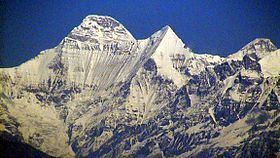Prominence 260 m | Elevation 7,434 m | |
 | ||
First ascent 1939 by Jakub Bujak and Janusz Klarner. Easiest route south ridge, from Lawan Gad via Longstaff Col: technical rock/snow/ice climb Similar Nanda Khat, Rishi Pahar, Nanda Ghunti, Nanda Kot, Hardeol | ||
Sunanda Devi (Hindi: सुनन्दा देवी) previously known as Nanda Devi East is the lower of the two adjacent peaks of the highest mountain in Uttarakhand and second highest mountain in India; Nanda Devi is its higher twin peak. Nanda Devi and Sunanda Devi are part of the Garhwal Himalayas, and are located in the state of Uttarakhand. The graceful peaks of twin mountains are visible from almost everywhere in Kumaon. The first ascent to the Sunanda Devi peak in recorded history appears to be in 1939 by Jakub Bujak and Janusz Klarner. The elevation of Sunanda Devi is 7,434 m (24,390 ft) and its prominence is 260 m (850 ft).
Contents
Religious Significance
Sunanda Devi is the lower eastern summit of the twin peaks of Nanda Devi a two-peaked massif, forming a 2 kilometres long ridge, oriented east-west. The western summit is higher, and the eastern summit earlier called Nanda Devi East is now also referred to as Sunanda Devi. Together the peaks may be referred to as the peaks of the goddesses Nanda and Sunanda. These goddesses have occurred together in ancient Sanskrit literature, Srimad Bhagvatam or Bhagavata Purana (Gita Press has a two-volume English and Hindi translation) and are frequently worshipped together in the Kumaon and Garhwal as well as elsewhere in India. Regarding certain mountains as sacred and associating them with specific Gods and Goddesses is a practice prevalent in other parts of Asia as well e.g. the volcanic Mount Fuji in Japan appears to have been named after the fire goddess. The first published reference to Nanda Devi East as Sunanda Devi appears to be in a recent novel (Malhotra 2011) that has the Kumaon region as backdrop. An annual Nanda Devi Raj Jat festival celebrating the two goddesses is popular in Uttarakhand.
The Himalaya have also been personified as the Lord Himavata, the God of snow, who is mentioned in the Mahabharata. He is father of Ganga and Saraswati, that became rivers, and Parvati an avatar of the great Mother Goddess Durga, who married Shiva and the goddesses Nanda and Sunanda who too are avatars or close spiritual associates of the goddess Durga.
Climbing History
A four-member Polish expedition led by Adam Karpiński climbed the Sunanda Devi peak in 1939 from Longstaff Col which is the standard route on the peak. The summit party was Jakub Bujak and Janusz Klarner. Another attempt to reach the Sunanda Devi peak in 1951 resulted in the death of two members of a French expedition in 1951. Tenzing Norgay who first climbed Mount Everest was a part of the support team. He and Louis Dubost climbed Sunanda Devi to look for the missing pair. Tenzing Norgay later stated that it was the most difficult climb of his life, even more difficult than Everest. Since then the peak has been reached by an Indo-French group in 1975 and perhaps also an Indian Army expedition in 1981 but the mountaineers in this last case did not survive to tell the story. The standard approach to the south ridge route is from the Milam Valley to the east, that passes through Lawan Glacier and onwards to Longstaff Col. The trek goes through the picturesque villages of Munsyari and Bhadeligwar.
Marco Dalla Longa led a large Italian expedition of twelve members to Sunanda Devi Summit in 2005. They approached the peak from Munsyari and the Milam valley. Camps were set up to 5400m. The Italian team made good progress on Sunanda Devi, through the central pillar on the east face. They were proceeding towards the summit when a long spell of bad weather from 9 September to 18 September made them sit up at the higher camps. Then tragedy struck the Italian team on Nanda Devi. Expedition leader Marco Dalla Longa died suddenly. He died by a coma stroke on 24 September. The team’s doctor suspected cerebral oedema. Longa was young and fit, with no health problems reported during the expedition up to that time. The entire expedition was evacuated by air from 27 September to Munsyari and to Delhi by air the next day.
Nanda Devi National Park and Valley of Flowers National Parks
Nanda Devi National Park along with the Valley of Flowers National Park are some of the most spectacular wilderness areas in the Himalayas. It is dominated by the peaks of Nanda Devi and Sunanda Devi of India’s second highest mountain which is approached through the Rishiganga gorge, one of the deepest in the world. No humans live in the Park which has remained more or less intact because of its rugged inaccessibility. It has a very diverse flora and is the habitat of several endangered mammals, among them the snow leopard, serow, himalayan musk deer and bharal. Nanda Devi National Park lies in eastern Uttarakhand, near the Tibetan border in the Garhwal Himalaya, 300 km northeast of Delhi.
